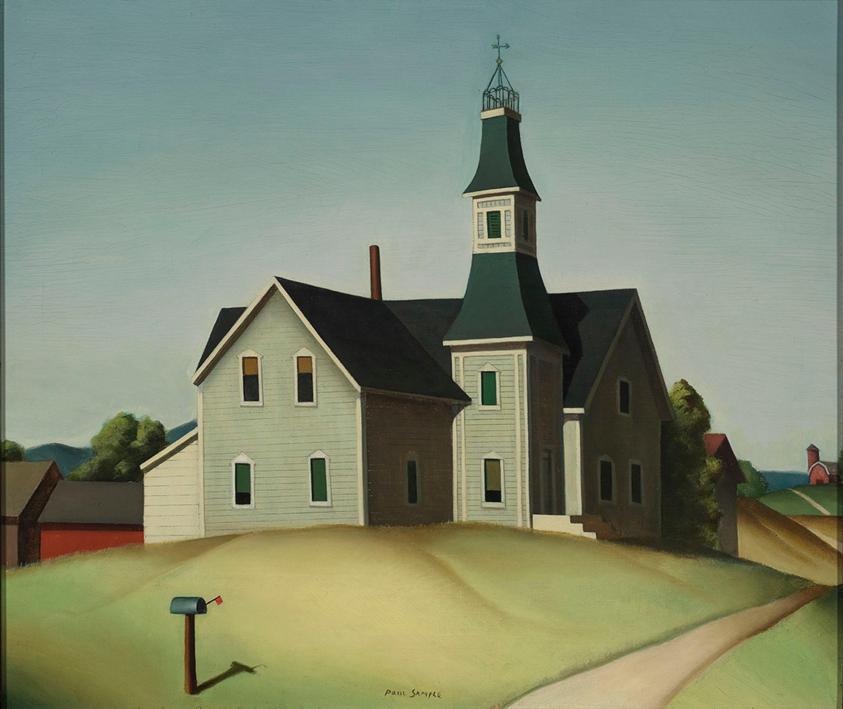
Artist:
Paul Sample
Church in Evansville (Schoolhouse)
Medium: Oil on canvas
Date: 1934
Dimensions:
Framed: 29 5/16 x 33 1/2 in. (74.5 x 85.1 cm)
Support: 24 x 28 in. (61 x 71.1 cm)
Accession number: 2024.3.1
Copyright: © artist, artist's estate, or other rights holders
Curatorial RemarksAmerican artist Paul Starrett Sample (1896-1974) is best known for his Regionalist and social realist styles of painting, and his canvases often echo the smooth, cool lines of the Precisionist painters (including Charles Demuth and Charles Sheeler). His choice to set his works in the more rural areas of the country during the Great Depression drew comparisons in his lifetime to Grant Wood and Thomas Hart Benton.
Sample was born in Louisville, Kentucky and moved frequently with his family. He graduated from Dartmouth College, where he studied architecture, in 1921. Both he and his brother contracted tuberculosis, which deeply impacted their lives for several years in the 1920s. While in treatment, he studied painting with Jonas Lie and took classes at the Art Students League in Los Angeles and eventually enrolled at the Otis Art Institute. He taught art at the University of Southern California and Dartmouth and also created magazine illustrations during World War II.
It was Sample’s practice to drive the rustic roads of Orleans County in Vermont’s Northeast Kingdom—the region of the small town of Evansville—sketching what he saw. Often he had a companion, his wife or his brother-in-law, Edwin Clark, an author and professional book reviewer. The Evansville area provided abundant subject matter for Sample: the village store, a group of barns, the church—all painted in 1933 and 1934. The subject of this painting, once a church (and apparently a schoolhouse, as Sample inscribed “Schoolhouse” on the stretcher), is now a bric-a-brac shop that stands on the northern side of State Route 58.
In 1935 and 1938, Sample painted “Evansville in the Fall” and “Storm near Evansville.” Although Sample painted a small Evansville scene in 1941, he did not devote significant attention to the subject again until 1946. The Samples were probably unable to travel to the area by car because of the rationing of gasoline during World War II.
“Church in Evansville” was likely started in Vermont and completed when Sample returned to Pasadena in the fall of 1934 to teach at the University of Southern California. It is one of a group of paintings that were exhibited at Ferargil Gallery in New York in March 1935.
Sample was born in Louisville, Kentucky and moved frequently with his family. He graduated from Dartmouth College, where he studied architecture, in 1921. Both he and his brother contracted tuberculosis, which deeply impacted their lives for several years in the 1920s. While in treatment, he studied painting with Jonas Lie and took classes at the Art Students League in Los Angeles and eventually enrolled at the Otis Art Institute. He taught art at the University of Southern California and Dartmouth and also created magazine illustrations during World War II.
It was Sample’s practice to drive the rustic roads of Orleans County in Vermont’s Northeast Kingdom—the region of the small town of Evansville—sketching what he saw. Often he had a companion, his wife or his brother-in-law, Edwin Clark, an author and professional book reviewer. The Evansville area provided abundant subject matter for Sample: the village store, a group of barns, the church—all painted in 1933 and 1934. The subject of this painting, once a church (and apparently a schoolhouse, as Sample inscribed “Schoolhouse” on the stretcher), is now a bric-a-brac shop that stands on the northern side of State Route 58.
In 1935 and 1938, Sample painted “Evansville in the Fall” and “Storm near Evansville.” Although Sample painted a small Evansville scene in 1941, he did not devote significant attention to the subject again until 1946. The Samples were probably unable to travel to the area by car because of the rationing of gasoline during World War II.
“Church in Evansville” was likely started in Vermont and completed when Sample returned to Pasadena in the fall of 1934 to teach at the University of Southern California. It is one of a group of paintings that were exhibited at Ferargil Gallery in New York in March 1935.
On view